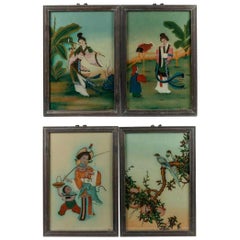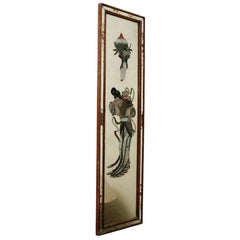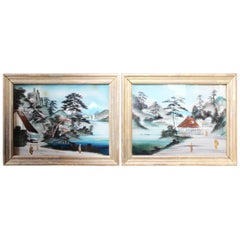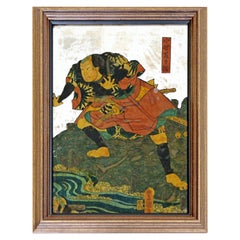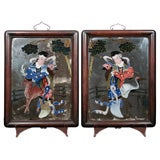Japanese Reverse Painting
to
1
5
5
1
4
1
1
1
3
2
1
1
1
4
4
4
5
5
5
Sort By
Set of Four Japanese Reverse Paintings
Located in Locust Valley, NY
Set of four Japanese reverse paintings.
Category
Early 20th Century Japanese Paintings and Screens
Materials
Glass
Japanese Reverse Painting on Mirror, circa 1937
Located in Los Angeles, CA
Japanese reverse painting on mirror.
Category
Vintage 1930s Japanese Wall Mirrors
Materials
Mirror, Wood, Paint
Pair of Japanese Reverse Glass Painting
Located in Charleston, SC
Fine early 20th century pair of Japanese reverse glass painting landscapes featuring each a lake
Category
20th Century Japanese Other Decorative Art
Materials
Glass, Wood
Antique Japanese Samurai Reverse Mirror Painting Framed
Located in Keego Harbor, MI
For your consideration is an antique, very rare, framed, Japanese Samurai reverse mirror painting
Category
20th Century Paintings
Materials
Paper
Pair of Reverse painted and MIrrored Japanais Paintings
Located in Hinsdale, IL
Hand-blown glass with hand-painted design over silvered glass to create background mirror.
Category
Antique 19th Century Japanese Paintings
Get Updated with New Arrivals
Save "Japanese Reverse Painting", and we’ll notify you when there are new listings in this category.
Japanese Reverse Painting For Sale on 1stDibs
Choose from an assortment of styles, material and more with respect to the Japanese reverse painting you’re looking for at 1stDibs. A Japanese reverse painting — often made from metal, wood and fabric — can elevate any home. There are 45 variations of the antique or vintage Japanese reverse painting you’re looking for, while we also have 6 modern editions of this piece to choose from as well. There are many kinds of the Japanese reverse painting you’re looking for, from those produced as long ago as the 18th Century to those made as recently as the 21st Century. Each Japanese reverse painting bearing Art Deco, Arts and Crafts or Georgian hallmarks is very popular. A well-made Japanese reverse painting has long been a part of the offerings for many furniture designers and manufacturers, but those produced by Tiffany & Co., Charlotte Horstmann and Sam Francis are consistently popular.
How Much is a Japanese Reverse Painting?
A Japanese reverse painting can differ in price owing to various characteristics — the average selling price 1stDibs is $6,500, while the lowest priced sells for $600 and the highest can go for as much as $107,055.
Questions About Japanese Reverse Painting
- How do I reverse paint on glass?1 Answer1stDibs ExpertApril 5, 2022The first step in reverse glass painting is to select your design and to transfer it to a pane of glass. From there you can paint in your design. Once the paint is dry and set, you can proudly display your artwork from the unpainted side that will have no exposed paint and will be less prone to chipping.
- 1stDibs ExpertApril 5, 2022Reverse painting is a method of glass art. The artist paints the back of a glass panel so the finished work can be seen from the opposite side. The technique is centuries old and pieces can be found in a variety of art styles. Browse a selection of reverse painted pieces on 1stDibs.
- 1stDibs ExpertApril 5, 2022Reverse painting on glass is called verre églomisé. The term gets its name from the 18th-century decorator Jean-Baptiste Glomy who became famous for his reverse-painted glass prints. On 1stDibs, you can shop a collection of verre églomisé furniture and jewelry.
- 1stDibs ExpertMarch 22, 2022Japanese paintings have many names, based on their style. Works produced after 1900 are known as Nihonga and combine traditional techniques with modern themes. Sumi-e are traditional Japanese ink paintings, while Ukiyo-e are figure and landscape paintings from the 17th to 19th centuries. On 1stDibs, find a range of Japanese art.
- 1stDibs ExpertApril 5, 2022Japanese screen painting is the art of creating byōbu, or Japanese screens. Byōbu vary in subject matter and style. The screens are free-standing, portable and decorated with symbolic images or calligraphy. It is common to find byōbu in pairs with at least two panels. Shop a selection of byōbu on 1stDibs.
- 1stDibs ExpertApril 5, 2022Japanese painting is called “nihonga”. This style of painting is characterized by a reduced color palette, a lack of shadows and simple expression. Works in this style are often created with mineral-based paints on scrolls and screens and depict landscapers, women and scenes from Japanese history and culture. You’ll find a wide range of nihonga art on 1stDibs.
- 1stDibs ExpertApril 5, 2022A Japanese silk painting is identifiable by its depictions of everyday life and scenes that are abundant with detail. The red seal or chop can also help you determine the artist of the piece. You can shop a collection of expertly vetted Japanese silk paintings from some of the world’s top sellers on 1stDibs.
